Did you start humming the ever-popular lyrics from Barbara Streisand’s song dubbed ‘Evergreen’ as you read the title? Classic melody, indeed.
It’s still at the top of millions of playlists as it remains popular—the lyrics remain relevant through time to a large audience—regardless of age.
It’s precisely what you must achieve with the content on your website. You must aim at getting readers to tag your page as a ‘must-have’ guide or link to it for special instructions or insight on your area of expertise. You want to create the need for users to tag their friends or share your page with colleagues.
Not only today but again in a few months and again in two years—without you having to refresh a single line of text, ever.
Is this even possible? With the increase of expert opinions online, how can you ensure that your content is evergreen, relevant, and on the 1st page of the SERP?
As a global advertising agency tackling these challenges daily, we can assure you it is possible, and worth it for lasting positive results.
Stay with us as we explore the principles of how to write and optimise an evergreen article and the benefits to your investment and website analytics over time. After reading to the end, you’ll have answers to:
- What is Evergreen Content?
- Why is Evergreen Content important?
- Tips on how to write Evergreen Content.
- How does Evergreen Content boost traffic?
WHAT IS EVERGREEN CONTENT?
It is content that remains accurate and relevant outside of time. You apply various SEO solutions to optimise evergreen content for SERPs and ensure that it’ll stay fresh and relevant for years to come.
When you compare it to typical website content, the topics and themes stay search-worthy long after you publish it, and the organic traffic it generates increases the longer it remains online—not decrease.
So, what is evergreen content and what isn’t?
When we consider the various themes and styles used for creating website content, the following content styles are worth considering if you want to write an evergreen article:
| 1. How to guides | 6. Glossaries |
| 2. Listicles | 7. Research Studies |
| 3. Product guides | 8. Testimonials |
| 4. Product reviews | 9. Case studies |
| 5. Tips | 10. Calculators and tools |
Compared to seasonal content such as political elections, major sports events and scores, or pop culture—an evergreen article focuses on information that does not change over time or that only produces quick spikes in your traffic that dissipate a month later.
In short, it is content that users need and can use repetitively because the data remains unchangeable.
If we look at a further breakdown of the most popular evergreen title types as indicated by a survey completed by Conductor, we note that numbered list rank as the most read type of evergreen content.
The breakdown is as follows:
- Numbered listicles = 36% (10 Ways to make coffee on fire)
- Reader addressing articles = 21% (Ways you can make coffee on fire)
- How to articles = 17% (How to make coffee on fire)
- Standard – 15% (Ways to make coffee on fire)
- Questions – 11% (What are ways to make coffee on fire?)
Let’s take a quick look at evergreen VS seasonal examples:
A) AN EVERGREEN ‘HOW-TO’ GUIDE
‘How to’ guides are instructional content that answers questions accurately and thoroughly. It should start at the very first step and take the ‘how-to’ process through to completion for the reader.
‘How to’ guides give the reader a step-by-step solution to specific problems or tasks—this is obvious. But how timeless is your guide?
Example: ‘How to fry bacon?’
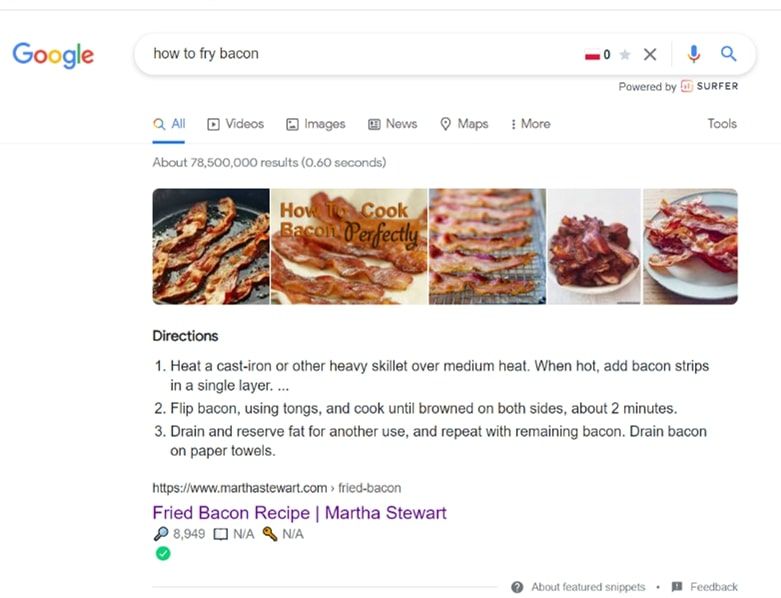
The top SERP result for this timeless query is an article published by Martha Stewart all the way back in November 2000.
What is important to mention here is that the author is a well-known and trusted publisher. Her articles are always accompanied by high-quality images and content that make you want to stay on her page longer.
It’s a great example of the perfect evergreen ‘how-to’ guide. More evergreen content examples that hit the nail on the user intent head is articles published regularly by home renovators. With topics ranging from ‘how to build a shoe stand’ to ‘how to fix your gutter’—this market is an excellent example to investigate and learn from.
If you’re an expert in your field, ‘how to’ articles are a great way to gain topical authority and brand recognition. Make sure to use your words carefully, answer the query concisely and that what you say is tried and tested.
The fastest way a publisher will lose any trust already gained is by giving incorrect instructions to users. The probability that they’ll contact you and complain are rare. The chance that they’ll never revisit your website or leave negative remarks on Trust Pilot are bigger.
B) AN EVERGREEN LISTICLE
Journalist and bloggers often use this short-form format of writing when a list is sufficient as the thematic structure of an article. Keeping it evergreen is the challenge though.
An excellent example of an evergreen listicle would read: ‘14 Exercises that keep men young.’
Vs.
A listicle that will spike for a few days or weeks, never to be seen again, that will read: ’14 men that use exercise to stay young.’
*Note from editor: Admittedly your list can stay at the top for a few weeks longer if you post a shiny image of whatever Hollywood Hero is trending right below your title—but not even that will keep your spot at the top for long.
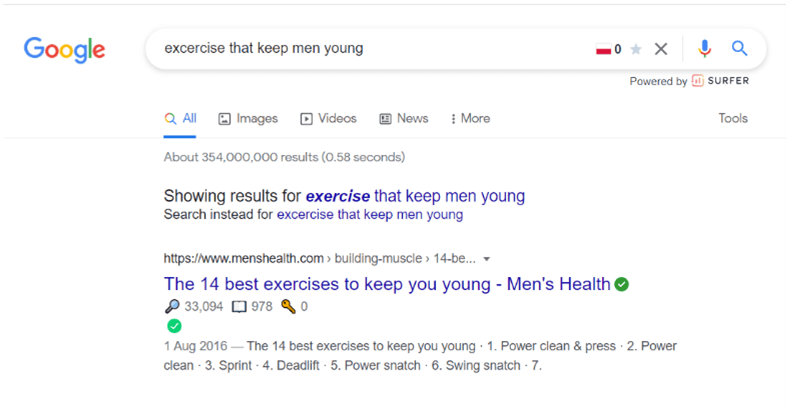
The #1 search result for the ‘evergreen listicle’ we queried is an article published by Men’s Health back in August 2016.
To avoid search engines crawling your content and classifying it as a ‘cheap-shot’ at gaining better rankings, your content that accompanies the listicles must comply to E-A-T principles throughout—delivering a good quality and well-researched paper with accurate data.
The title of a listicle will most likely also contain the number of points you are addressing. You can present your list in ‘countdown’ order with the #1 either first or last in the sequence.
PRO TIP: Your reader will spend more time reading your article if you keep the best for last—in other words listing #1 at the end of your listicle.
THE SEO BENEFITS OF EVERGREEN CONTENT?
Why is evergreen content important for an effective SEO strategy?
Evergreen articles and pages are pivotal for implementing a strategy in which competitive keywords rank well on the SERPs. Any content takes time to rank, but optimising evergreen content with a high DA backlink SEO strategy will get you closer to the top—and help you to stay there—actively contributing to a consistently increasing ROI.
By combining these two practices in your SEO strategy and actively promoting your content to your target audience your evergreen articles will increase in visibility and performance as time goes by.
Due to the evergreen nature of your content, it will also gain more backlinks over time. It all adds up to a piece of gold that keeps on gaining traction and yielding excellent results.
In a nutshell—it is the secret to success for your website if you want organic traffic that keeps on growing over time, getting backlinks, and ranking well for relevant keywords.
Case Study: The team at Ahrefs—regular bloggers—used evergreen content as their sole strategy for growing their blog from 15,000 visitors to more than 200,000 per month in only three years.
There’s a reason why you won’t find the typical seasonal industry updates on their site. They stick to publishing classic and timeless content—and it works!
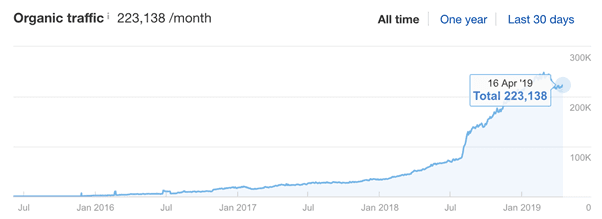
THE BENEFITS OF PUBLISHING EVERGREEN CONTENT INCLUDE:
- It provides you with a higher ROI as it compounds in value over time as it pulls more site traction and accumulates organic traffic.
- It increases the probability of relevant and high DA websites linking back to your content.
- If you’re producing high quality E-A-T content in a timeless manner, it will lower your website’s bounce rate.
- Time spent on each page will increase, which in turn tells the search engines that your content is valuable and fulfilling user intent. This is what keeps evergreen content at the top of the SERPs.
- It continues to generate leads for your business long after the publication date.
HOW TO DEVELOP AN EVERGREEN CONTENT STRATEGY FOR SEO?
Developing an effective evergreen content strategy plays a massive role in modern-day SEO practices. If it’s done correctly, the benefits are long-term—making your work as SEO easier over time as the content increasingly reaps in the rewards for you. Almost like a passive income. Perfect!
Let’s explore the key aspects which determine the longevity of your content.
#1 IDENTIFY EVERGREEN TOPICS
Although there are excellent articles available about how to create evergreen articles, most do fail to mention that there are two sides to this story.
Make sure you focus on evergreen content AND evergreen topics when you develop your evergreen content strategy. You need to hit the bar on both if you still want to rank in the top 10 in five years from now.
WHAT IS AN EVERGREEN TOPIC?
Let’s look at some examples to make this easy:
| Evergreen topics | Vs. | Seasonal topics |
|---|---|---|
| 1. How to change a bike tyre? | Vs. | How to change a Raleigh tyre in 2021? |
| 2. How to lose weight? | Vs. | The best lockdown weight loss programme? |
| 3. How do the US elections work? | Vs. | US Election results 2021? |
| 4. How to choose the best online casino for Baccarat? | Vs. | The best online casino for Baccarat? |
Any cyclist can still refer to your first title for years to come. In the second title the content is marginalised by two elements: type of bike and time.
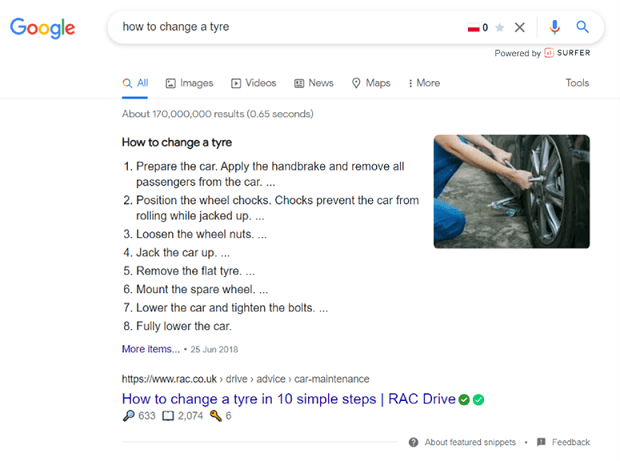
When searching for ‘how to change a tyre’ the top result is from an article published in June 2018.
Only evergreen content has the power to remain at #1 for more than three years.
The same principle is at play in the example of the online casino topics.
While the evergreen topic will remain accurate and timeless for years, the second example: ‘the best online casino for Baccarat’ can’t remain relevant with the amount of new online casinos emerging daily. You’ll see a quick spike in traffic, but it won’t last.
If you want to create the perfect evergreen topic you must research themes that generate consistent interest and high search volumes over time.
#2 CREATE EVERGREEN CONTENT TO MATCH THE TOPIC
Now that you’ve chosen a topic that will last through the ages, your content about the topic must match its classic counterpart and deliver information that will stand the test of time.
How to change a bike tyre must give any bike owner the general low-down of changing a tyre—on any type of bike. Here you’ll focus on the key aspects that transcends makes and models.
If you only offer advice on how to change a tyre on Raleigh bikes, the Googlebot will figure out very quickly that your title and content are mismatched. It can lead to the search engine penalising your article instead of indexing it correctly and featuring it at the top of the SERP.
PRO TIP: It doesn’t mean you can’t elaborate on more specific data within your article. But you must answer the search query first, before offering other advice further down.
Neglecting to answer the search query concisely will lead to increased bounce rates and the search engines will see this as a negative indicator for the quality of your content—hence your rankings will drop instead of increase—even with the perfectly optimised evergreen topic and title in place.
#3 OPTIMISE EXISTING CONTENT TO BE MORE EVERGREEN
Yes, you can successfully refresh old content and make it evergreen, but you must do it without breaking any of Google’s content policies.
You can start by removing any elements that bind your content to specific seasons, events, or products that are outdated. If you’ve replaced a specific product with a newer version, update your product pages and blogs with the latest version, and ensure all the links on your page are still relevant and active.
When asked the ever-recurring question about whether updating or removing publication dates on articles will help to make it evergreen, Google’s John Mueller responded that “If it’s evergreen, then by definition you don’t need to change it. No need to do anything special. Why would a great article be disadvantaged by a date?”
You can also replace keywords with more relevant ones that has better search volumes if it fits the purpose of your article. Once again—avoid keyword stuffing or using irrelevant keywords merely for the sake of ranking. It’ll affect your overall page UX quality and the crawlers might avoid *indexing the page due to it.
*Make sure that your page is indexed. If the crawlers haven’t done it automatically, you can manually prompt it by adding it to your XML sitemap or sending the page URL via Google Search Console.
How to submit your URL manually to get indexed?
|
Editor’s note: Be careful not to change old publications just for the sake of seeking higher rankings. Google will know! When optimising old content make sure to make valid and verifiable changes to the data.
SEO TIPS FOR PRODUCING EVERGREEN ARTICLES
It’s important to understand that there are two vital steps to follow if you want to consistently write evergreen articles:
- Finding evergreen topics
- Writing evergreen content that answers the topic’s user intent
We’ll look at both steps in detail to help you create content that will rank well years from now.
STEP 1: CONDUCT A THOROUGH SEARCH FOR EVERGREEN TOPICS
The best advice when searching for topics is to avoid trendy topics and instead focus on those that show consistent search traffic. To do this you need to start the SEO process with thorough keyword research.
FIND KEYWORDS WITH HIGH SEARCH VOLUMES & CHECK THE KEYWORD’S LONG-TERM TREND
Before you start looking for the best keyword to target, you must decide which topics you want to focus on in your content strategy. Once you’ve established your topics, you can use your preferred keyword tool and enter them.
If the topic has high search volume and it’s trend has gained upward traction over time it’s a pretty good indication that it’ll make a good topic for your next evergreen post. Avoid selecting topics that are very competitive SEO wise. That’s when you apply tools like KWFinder, Ahrefs, SEMrush and Google Trends to make more data-driven decisions for your long-term strategy.
Let’s see what we find for our first topic ‘How to change a bike tyre’ when using KWfinder by Mangools:
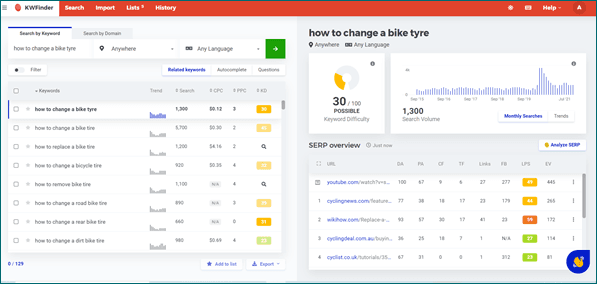
You can now have a clear view of keywords and their search volumes. You can also see which of your competitors rank best for the specific topic and keyword.
PRO TIP: Include keywords with lower search volumes if it fits your topic well. The keyword difficulty will be much lower—increasing your chances to rank well for it on the SERPs. Using such keywords in your title and meta tags for optimal visibility.
Many keywords only have high search volumes for a short period of time, or seasonal spikes. To ensure you’re targeting evergreen keywords for your topic make sure that it shows a positive upwards trend, and not seasonal spikes or a declining trend.
STEP 2: WHAT ARE THE TOP-RANKING PAGES FOCUSING ON?
Competitor analysis must be a solid part of any SEO endeavour you set out on. Look at the top performing pages for your chosen topics and keywords (the evergreen ones that has lasted for years) and gain some insight at what has kept them at the top.
STEP 3: CHECK YOUR CHOSEN TOPIC’S PERFORMANCE ON GOOGLE TRENDS
Google Trends will show you how specific topics have performed over time. It’s a great tool to separate evergreen topics from seasonal ones and should give you a clear indication of whether to proceed or change your approach and themes.
STEP 4: PRODUCE EVERGREEN CONTENT
It’s not difficult to create true evergreen content that will serve you well for years to come. If you can manage to avoid the urge to jump on every trending bandwagon your content will automatically take on a more classical approach. You must separate any ‘fluff’ from the primary search intent and only focus on the latter—consistently.
When planning your SEO evergreen content strategy, find your brand’s voice of expertise. What do you want to be known and trusted for? Build your content strategy around your specific niche with well-rounded evergreen articles.
If you want the top search engines to recognize your content as evergreen you must deliver the best possible answers and solutions to satisfy the user search intent today, next week, and next year.
To do that, these next steps are vital in your evergreen content SEO strategy:
#1: PRODUCE 10X CONTENT EVERY TIME & DELIVER E-A-T CONTENT
In our opinion there is only one sure way to create 10X content and that is to focus on Google E-A-T principles. That means your article must show Expertise, Authority, and Trustworthiness. It must be 10 times more informative, trusted, and accurate than any other publication on the topic.
If your website is classified as YMYL, this step is crucial if you want to pass the Google E-A-T algorithms. In short: if you say something that can affect a user’s health, wealth, or happiness you must be able to back it up with credentials and proof on your website.
How to create 10X content consistently?
Quality: Is the website design great? Is the content easy-to-read? Is it interesting, entertaining, or useful? Does the content solve the problem? Uniqueness: Why would someone choose your content over others? Authority: Are you an expert in this niche/topic?”—Ahrefs
#2: FOCUS ON YOUR NICHE
Evergreen articles are not created around trending topics and themes, it focuses on very precise search queries and answers it accurately. It will help to identify your most valuable customer segment and create content based on their likes and needs.
As part of your SEO content strategy, it’s advisable to first determine your customer personas and then build your evergreen content strategy around their frequently asked questions or queries.
#3: AVOID ANY FORM OF REFERENCE TO POP-CULTURE OR FLEETING TRENDS
You can have the best evergreen topic but still fail terribly at producing evergreen content. Although many content creators enjoy referring to trending movies, characters, or music—to ‘newsjack’ a popular trend or topic—it will cripple your attempt at producing classic articles that stands the test of time.
Other types of articles that are not classified as evergreen content ideas include:
- News articles
- Trend-focused articles
- New product announcements
- Statistic-based articles
#4: CONSISTENTLY ANALYSE YOUR PAGE PERFORMANCE
Your job is not done once you’ve published an article. This is when the real SEO work starts if you’re serious about ranking among the best in your field with lasting content.
Monitor your page performance at regular intervals using tried and tested SEO tools and comparing it to your results on Google Analytics. If it is gaining traction over time (even slowly, but upwards) you’ve created and evergreen article—well done!
If the page shows inconsistent spikes, you might need to make some changes to the content or site structure. Ensure that your page is optimised after relevant core updates by the search engines.
Always identify your best performing pages and replicate what works for your brand and niche.
#5: COPYWRITER’S NOTE: WRITE FOR REAL PEOPLE!
The secret to getting evergreen content read, shared, and tagged is to ensure you write for real people.
Your article must have a good readability score. Don’t use such industry specific slang that the average user—or beginner in your niche—bounces of your page after reading the opening sentence.
Using an editing app like Hemingway® makes it quick to adjust your content and secure the perfect grade. You should aim for a score of between grade 7 and grade 9 when creating evergreen content.
It ensures that your article is concise and usable for a larger audience.
Write concisely and resist the urge to refer to current events and pop-culture that readers in 3 years won’t relate to.
There is a fine line between giving expert advice versus antagonizing 90% of your potential future clientele. Never use sarcasm, bad jokes about your competitors, or show any bias relating to sensitive topics—avoid making comments about politics, current events, and religion in an evergreen SEO strategy. Unless you’re a journalist reporting actual news—always remain neutral.
READY TO OUTLAST THE REST?
Focusing on evergreen content as part of your SEO strategy is a sure way to work less in the long run. The nature of it is to continually grow and increase organic traffic to your site.
When you start an evergreen content strategy you must create multiple high-quality articles and pages—but in the long run you won’t find yourself pushing two or three blogs per week just to remain visible on the SERPs anymore.
That is the beauty of evergreen content. It continues to increase your organic traffic, Click Through Rates and Return On Investment long after it’s published.
If you’ve recognised the value of a solid evergreen content strategy, but need more advice or expert help, contact us and one of our senior team members will be happy to discuss solutions with you.
SEO Content Manager
Clarissa is an SEO Content Manager at MediaGroup Worldwide. She has 1.5 years of experience working with clients in the financial and tech sectors, creating strategies and producing copy across a wide range of content types, including landing pages, educational articles, and white papers.
Popular categories:
The Memorable Marketing by MediaGroup podcast series interviews leading senior marketers worldwide on all things marketing, campaigns, strategy, building awareness and everything that makes a brand successful.
Join the conversation by leaving your thoughts and questions, and we will be happy to chat with you. If you want to discuss your business marketing strategies in more detail or join our podcast as a guest, please reach out to us at: [email protected]
Latest Insights
Article
Responsive Search Ads to become the default on Google Ads
On 31 August 2021, Google announced changes to their search ad type. After 30 June 2022, Responsive Search Ads (RSAs) will become the only search ad type to be created or edited in search campaigns. Expanded Text Ads (ETAs) can continue serving on Google Ads, and we will still be able to pause and resume them. But new ones cannot be created, and existing ones cannot be edited.
Quarterly marketing insights in our newsletter
We are committed to helping you get the best results in your digital marketing game. Our experts will give you actionable insights and knowledge, based on our experience, to tackle the biggest marketing challenges. Unsubscribe at any time.
Mediagroup Worldwide processes the above information in order to subscribe you to the newsletter. Privacy Policy
